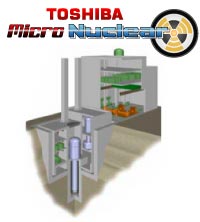Toshiba has developed a new class of micro size Nuclear Reactors that is designed to power individual apartment buildings or city blocks. The new reactor, which is only 20 feet by 6 feet, could change everything for small remote communities, small businesses or even a group of neighbors who are fed up with the power companies and want more control over their energy needs.
The 200 kilowatt Toshiba designed reactor is engineered to be fail-safe and totally automatic and will not overheat. Unlike traditional nuclear reactors the new micro reactor uses no control rods to initiate the reaction. The new revolutionary technology uses reservoirs of liquid lithium-6, an isotope that is effective at absorbing neutrons. The Lithium-6 reservoirs are connected to a vertical tube that fits into the reactor core. The whole whole process is self sustaining and can last for up to 40 years, producing electricity for only 5 cents per kilowatt hour, about half the cost of grid energy.
Toshiba expects to install the first reactor in Japan in 2008 and to begin marketing the new system in Europe and America in 2009.


1 comment:
Maybe I'm wrong, but I have a feeling this'll fail in the US if they don't yank the word "Nuclear" out of it's name. People in the US are paranoid about nuclear energy, and a lot of them use the Three Mile Island incident in '79 as an excuse. But, despite it being the worst nuclear incident in the US, TMI was NOT that bad. Look at the article on TMI at the NRC website (nrc.gov) and read ... "Detailed studies of the radiological consequences of the accident have been conducted by the NRC, the Environmental Protection Agency, the Department of Health, Education and Welfare (now Health and Human Services), the Department of Energy, and the State of Pennsylvania. Several independent studies have also been conducted. Estimates are that the average dose to about 2 million people in the area was only about 1 millirem. To put this into context, exposure from a full set of chest x-rays is about 6 millirem. Compared to the natural radioactive background dose of about 100-125 millirem per year for the area, the collective dose to the community from the accident was very small. The maximum dose to a person at the site boundary would have been less than 100 millirem. In the months following the accident, although questions were raised about possible adverse effects from radiation on human, animal, and plant life in the TMI area, none could be directly correlated to the accident. ... However, comprehensive investigations and assessments by several well-respected organizations have concluded that in spite of serious damage to the reactor, most of the radiation was contained and that the actual release had negligible effects on the physical health of individuals or the environment." And, since TMI, measures have been taken to insure another such incident will not ocurr in the US...
FYI: you can take a stroll along the Susquehanna river (which TMI is on) and it's really pretty, even with TMI right there.
Post a Comment